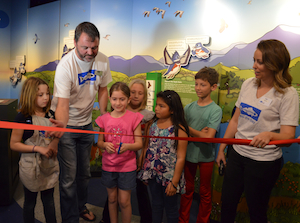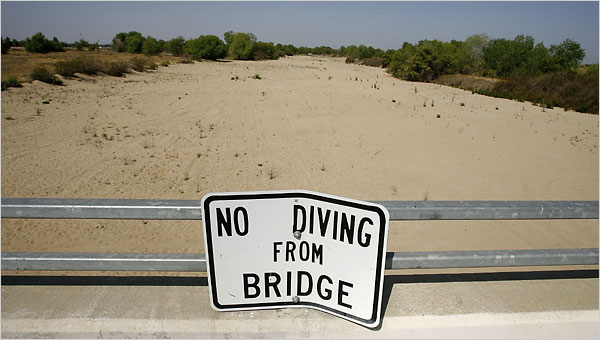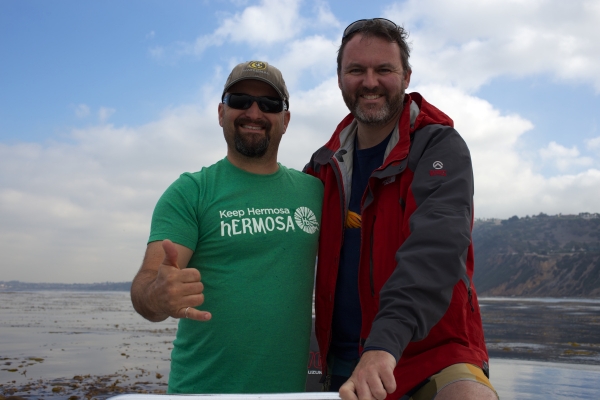Peter Shellenbarger, a Heal the Bay science and policy analyst, and James Alamillo, Heal the Bay’s urban programs manager, say plans for revitalizing the L.A. River may soon hit a snag.
The Los Angeles River has been getting a lot of attention lately. It also may soon get some much-needed TLC, in the form of extensive revitalization plans now being debated by a complex web of local, state and national agencies.
Various government units and community groups are assembling detailed plans for bringing the river and its many tributaries back to fuller life, such as the U.S. Army Corps’ ARBOR plan or the recent expansion of L.A. River kayaking programs.
Revitalizing the L.A. River and its tributaries would obviously provide enormous environmental, economic, recreational and social benefits to Southern California.
But these visionary projects may soon hit a bump in the river, as it were.
A new study by the Los Angeles Regional Water Quality Control Board, to be debated in the coming months, could undermine legitimate opportunities to expand green space and recreational opportunities for millions of residents in L.A. County.
In a nutshell, the Regional Board has been gathering data about recreational uses along 44 miles of river. Many observers are concerned that the new study, known as RECUR, will be used to delist or redesignate beneficial recreational uses along several major segments of the L.A. River and its tributaries, such as Arroyo Seco, Verdugo and Compton Creek. The specter of reduced protections is now clouding many of the grand visions to bring the Los Angeles River and its tributaries back into greater public use.
If the board ultimately decides to eliminate designated recreational beneficial uses along many stretches of the river and its tributaries, there will be less regulatory oversight provided to these reaches. If parts of the river are viewed as not having recreational use potential, water quality standards would be relaxed in those areas.
Some dischargers welcome such changes because weakened protections make it easier and less expensive to meet compliance standards. But the changes could result in a regulatory hodgepodge on the river, where different sections receive different water quality protection. It’s a dangerous precedent.
Delisting or redesignation also would result in less protection of parts of the river with recreation potential, creating fewer incentives to enhance them in revitalization plans. Designers would obviously think twice about siting public amenities in spots with compromised water quality.
There are numerous efforts underway by many community and government groups to transform the L.A. River from a largely concrete channel into a healthy ecosystem. Projects are being pursued by Heal the Bay, City of Los Angeles, Los Angeles County, California Coastal Conservancy, California State Parks, California Department of Water Resources, Mountains Recreation and Conservation Authority, amongst others.
So a number of interested parties are watching the RECUR study very closely. The report does provide some valuable information about the Los Angeles River and its tributaries, such as confirming what recreational uses are happening in various reaches. But the study has significant flaws.
Most important, the report is merely a snapshot in time and fails to capture a full picture of potential recreational uses in and along the river.
The board’s process for judging the recreational value of river stretches seems like a bit of Catch 22 logic. Many areas are being considered for recreational delisting because the Board says no one uses them. But in reality, most of these stretches are either fenced off or posted as being illegal to use. One could reason that no one is using them, although this is not always the case.
RECUR’s timeframe does not adequately reflect current uses of the Los Angeles River or its tributaries, or possible uses if existing legal restrictions are removed. For example, kayaking on the Los Angeles River is so popular that a second designated spot has been opened along a section of the Glendale Narrows. But RECUR doesn’t take these uses into account, as they were not taking place during the study period. The random two-hour observations included in the study took place from July 2011 to December 2012
Heal the Bay staffers have observed bathers in Compton Creek, yet the presented study results indicates that no observed or reported recreational activities occurred along this stretch.
In essence, under the proposed delisting portions of the river will largely be “written off” for revitalization because they will no longer be viewed as worthy of potential recreational use or protection. That may be useful to dischargers, but it will seriously shortchange local residents who could benefit from expanded uses of the river that to this point have been untapped.
With limited resources for enforcement and compliance oversight, the Regional Board should prioritize the protection of established beneficial uses, instead of engaging in the messy process of removing them.
The Regional Board is now deciding if it will take action on the Technical Report and debate proposed amendments to the LA/Ventura Basin Plan. Among the discussion items would be the suggested changes to recreational beneficial-use designations in the Los Angeles River System.
In advance of any possible action, the Board is seeking public comment on the report. Staff is encouraging the public to submit written comments by Feb. 28. The process allows members of the public to express concerns about the draft feasibility report. Yes, the document is a bit of a slog, but the stakes are important. This is a great opportunity for the public to become involved in the decision-making process about the future of the L.A. River. Make your voice heard. Please send comments to the Board.
 Yes, people will criticize it from both sides – as either going too far, or not far enough. But this afternoon at the press conference at a manufacturing plant in Vernon it was heartening to see voices from labor, manufacturers, community groups and the environment come together. Everyone can rally around a solution that shows that California continues to lead on issues that are good for the environment and business.
Yes, people will criticize it from both sides – as either going too far, or not far enough. But this afternoon at the press conference at a manufacturing plant in Vernon it was heartening to see voices from labor, manufacturers, community groups and the environment come together. Everyone can rally around a solution that shows that California continues to lead on issues that are good for the environment and business. 




 Santa Monica Pier Aquarium aquarist Jose Bacallao shows Ruskin the ropes off Palos Verdes.
Santa Monica Pier Aquarium aquarist Jose Bacallao shows Ruskin the ropes off Palos Verdes.